Plants
Restoring Biodiversity with Native Plants
Starting in 2017 and again in 2018, in partnership with the National Park Service, the Friends of Dyke Marsh began to control invasive plants on a .065-acre area on the west side of the Haul Road trail and planted over 4,000 native trees and plants to restore the land to a healthier, more natural state. Over 40 dedicated volunteers and National Park Service staff planted the trees and plants. We received several grants and many generous donations (see below). Our goal is to restore a very degraded habitat. We estimate that around 80 percent of the plants and trees have survived.
 Invasive plants like porcelainberry (Ampelopsis brevipedunculata) are rampant along the Haul Road Trail. They can smother and outcompete native plants. Invasive plants like porcelainberry (Ampelopsis brevipedunculata) are rampant along the Haul Road Trail. They can smother and outcompete native plants. |
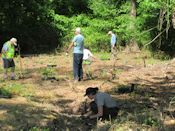 National Park Service/George Washington Memorial Parkway staff cleared the site of invasive plants like English ivy (Hedera helix L) and porcelainberry (Ampelopsis brevipedunculata). National Park Service/George Washington Memorial Parkway staff cleared the site of invasive plants like English ivy (Hedera helix L) and porcelainberry (Ampelopsis brevipedunculata). |
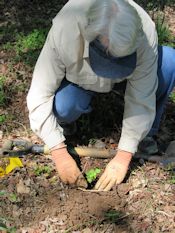 Volunteers planted native plants. Volunteers planted native plants. |
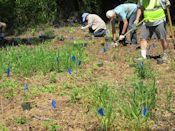 The blue flags designated each plant that volunteers planted. The blue flags designated each plant that volunteers planted. |
 Greg Crider and Melissa Westbrook, then the GWMP horticulturalist, planted a tree. Greg Crider and Melissa Westbrook, then the GWMP horticulturalist, planted a tree. |
Invasives’ Harm
Non-native or invasive plants like English ivy (Hedera helix L) and porcelainberry (Ampelopsis brevipedunculata) are well established and rampant along both sides of the trail. Why is this a problem?
Invasive plants displace native plants. University of Delaware entomologist Douglas Tallamy offers this in his book, Bringing Nature Home: “When a plant is transported to an area of the world that contains plants, animals and diseases with which it has never before interacted, the coevolutionary constraints that kept it in check at home are gone, as are the ecological links that made that plant a contributing member of its ecosystem.” In short, native plants support the native wildlife with which the plants coevolved.
Why Native Plants?
“Plants and animals evolve together to create unique natural communities, weaving a complex web of interrelationships,” according to the Virginia Department of Conservation and Recreation.
Native plants that produce nectar, pollen and seeds, serve as food for native birds, butterflies, bees and other wildlife. Many insects, like butterflies, depend on specific plants, called “host plants,” with which they co-evolved for their food and shelter. (See our butterfly and host plants checklist on this website.)
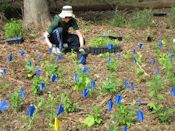 In 2018, we had a second round and planted more native plants. In 2018, we had a second round and planted more native plants. |
 Matt Bright with Earth Sangha, a partner, explained the value of native plants. Matt Bright with Earth Sangha, a partner, explained the value of native plants. |
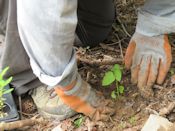 Volunteer Paul Siegel put in a plant. Volunteer Paul Siegel put in a plant. |
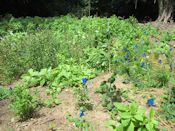 In July 2018, plants were about two to three feet tall. In July 2018, plants were about two to three feet tall. |
Here is one example of the importance of native plants to wildlife. At FODM’s September 2018 meeting, Dr. Desiree Narango, a University of Massachusetts ecologist, explained that native plants support a higher abundance and biomass of caterpillars than non-native plants. She said that a chickadee with four to seven young, needs between 390 to 570 caterpillars every day to feed their young. Therefore, caterpillars are very dependent on certain host plants.
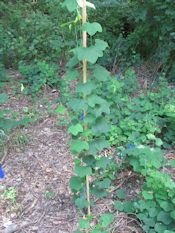 Yellow passion flower (Passiflora lutes L) returned. Yellow passion flower (Passiflora lutes L) returned. |
 Yellow passion flower (Passiflora lutes L). Yellow passion flower (Passiflora lutes L). |
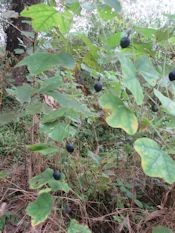 Yellow passion flower (Passiflora lutes L) berries in the fall. Yellow passion flower (Passiflora lutes L) berries in the fall. |
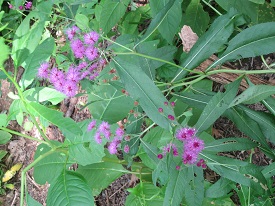 New York ironweed (Vernonia noveboracensis) New York ironweed (Vernonia noveboracensis) |
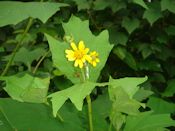 Hairy leaf cup/bears foot (Smallanthus uvedalia) Hairy leaf cup/bears foot (Smallanthus uvedalia) |
Native plants can improve ecological functionality of landscapes and provide ecological services like stormwater retention, cleaner air and erosion and sediment control. Native plants can improve soil health. Healthy habitats have plants and animals (producers and consumers) in balance. Increasing diversity of plants can help keep pest populations in check.
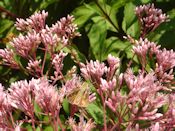 Joe Pye weed (Eutrochium purpureum) Joe Pye weed (Eutrochium purpureum) |
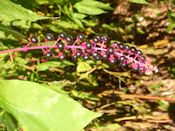 Pokeweed (Phytolacca americana) berries Pokeweed (Phytolacca americana) berries |
 A young common box turtle (Terrapene carolina) was at home on the site. A young common box turtle (Terrapene carolina) was at home on the site. |
By trying to control invasive plants and support more native plants, this project is one small way we can restore lost biodiversity, strengthen the resource base for wildlife and for people and create a more robust environment.
Controlling Invasive Plants
Since 2018, volunteer teams have diligently worked to pull up and root out invasive species, such as stiltgrass (Microstegium vimineum), mile-a-minute (Persicaria perfoliata), porcelainberry (Ampelopsis brevipedunculata), English ivy and others. This is an ongoing effort.
We try to have several sessions a month from May to October. In the winter, we work on controlling English ivy in multiple places. We train volunteers to identify about five targeted invasive plants and in the methods for controlling them. To join us, email This email address is being protected from spambots. You need JavaScript enabled to view it. with “Invasives” in the subject line and check our homepage for forthcoming events.
To learn about common invasive plants in the Washington, see “Plant Invaders of Mid-Atlantic Natural Areas” at https://www.invasive.org/alien/pubs/midatlantic/midatlantic.pdf.
For more information on Northern Virginia’s native plants, visit Plant NOVA Natives at www.plantnovanative.org and the Virginia Native Plant Society at www.vnps.org.
Partners, Grants
Our partners in this project are the National Park Service, Earth Sangha and the Audubon Society of Northern Virginia. Our efforts are also supported by grants from the Audubon Society of Northern Virginia, the National Environmental Education Foundation and the I-495/95 Express Lanes and by many generous member donors.
Thank you to Bob Veltkamp, Greg Nemetz, Bernie Krell and Colin Surovell for the sign noting the project. Thank you to Laura Sebastianelli for initiating two Chronolog stations, one at this site, both of which we installed. We encourage visitors to take photographs at the station and send them in. To view submitted photos, visit www.chronolog.io. Put “Dyke Marsh” in the box that says Filter by Project and our two cameras will appear.
Thank you to the dedicated employees of the George Washington Memorial Parkway, National Park Service, for partnering with us on this project.
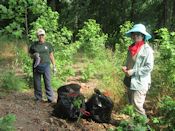 Trudi Hahn and Nancy Herrman helped remove invasive plants. Trudi Hahn and Nancy Herrman helped remove invasive plants. |
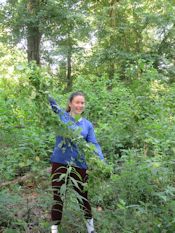 Mara Surovell tackled mile-a-minute (Persicaria perfoliata). Mara Surovell tackled mile-a-minute (Persicaria perfoliata). |
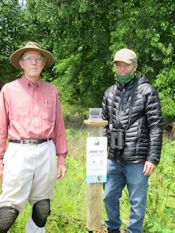 Jim Gearing and Ed Eder installed the chronolog station. Jim Gearing and Ed Eder installed the chronolog station. |
 In the spring, plants are about one foot high. In the spring, plants are about one foot high. |
 Colin Surovell and Bernie Krell installed a sign at the native plant site. Colin Surovell and Bernie Krell installed a sign at the native plant site. |
All photos by Glenda Booth.